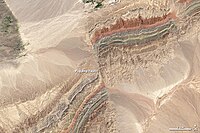
Photo from wikipedia
Recent global navigation satellite system (GNSS) data for the Japanese Islands have revealed a high-strain-rate region suggesting the existence of a region of broad-scale crustal deformation. The Niigata–Kobe Tectonic Zone… Click to show full abstract
Recent global navigation satellite system (GNSS) data for the Japanese Islands have revealed a high-strain-rate region suggesting the existence of a region of broad-scale crustal deformation. The Niigata–Kobe Tectonic Zone (NKTZ), which is the high-strain-rate zone in central Japan, shows a short-term dextral strain rate of ~ 12 mm/year. The total slip rate of the Quaternary fault zones in the NKTZ has been estimated as ~ 6.7 mm/year, accounting for just over half the short-term strain rate of the zone. However, this slip rate underestimates the total slip rate on faults within the NKTZ owing to possible distributed deformation on minor faults. This study quantifies the slip rate attributable to these other faults in the southeastern-central NKTZ and reveals the unique deformation structure across the high-strain-rate zone, which comprises a Quaternary fault core, a Quaternary fault damage zone, an incipient brittle shear zone (active background), and an inactive background. The spatial characteristics of the incipient brittle shear zone can be explained in terms of fault density, which increases toward the central NKTZ. Minor faults located > 500 m from major Quaternary faults but within the NKTZ have sense of shear consistent with that of the major faults. In contrast, minor faults outside of the NKTZ show sense of shear that differ from the dextral displacement of the high-strain-rate zone and do not contribute to the slip rate of the zone. The total slip rate of minor faults in the southeastern-central NKTZ is estimated to be 0.46–2.88 mm/year (roughly equal to a major Quaternary fault in the zone), which implies 4–24% of crustal strain is stored in the active background.
Journal Title: Earth, Planets and Space
Year Published: 2020
Link to full text (if available)
Share on Social Media: Sign Up to like & get
recommendations!